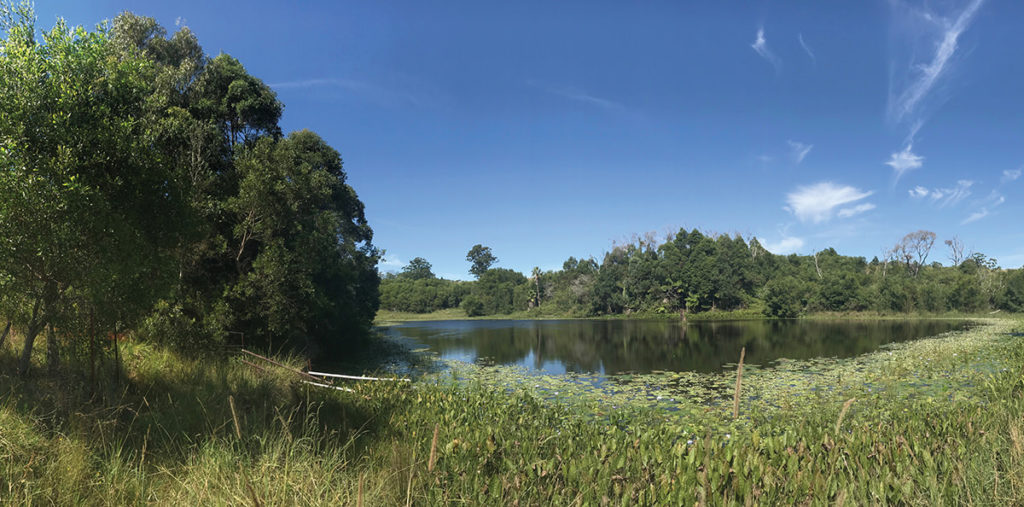Have you recently purchased or inherited a property that has vast expanses of cleared land that you are keen to revegetate and restore for wildlife? Or perhaps you have an opportunity to revegetate areas of paddock previously used to graze livestock? If this is the case, it is important to first ask, what is the aim of my planting?
It is likely that you will have one of two main aims:
- To set up vegetated corridors or ‘shelterbelts’ for wildlife and/or,
- To provide more permanent nesting or foraging habitat for wildlife.
This article provides you with ideas to help you set up your own restoration and revegetation goals on your property using the book Restoring Farm Woodlands for Wildlife as a guide.
What to Plant?
Planting native plants is the first rule of thumb for any restoration project. Planting native plants has the following benefits:
- Eliminates the risk of planting exotic species which can become weeds on your property;
- Certain native plant species may be planted to attract specific locally endemic or threatened fauna species;
- Native plants attract native invertebrates that can provide prey for native wildlife, predate on pest species and assist with pollination of native plants.
Native plants should be planted with consideration to which species grow in the best conditions and locations on your property. It is often best to contact your local Land for Wildlife Officer and request a native species list that is indicative of what species are likely to occur in and around your property.
When considering what to plant, it is also important to consider the structure of your planting. For example, once a canopy is established, planting a shrub layer and understory similar to what is naturally found in surrounding woodlands.
Recent studies show that plantings with an understory of wattles (Acaciaspp.) can limit the preference of foraging by aggressive Noisy Miner birds (Lindenmayer et al. 2010), a species which is known to drive away smaller native birds (Mac Nally et al., 2012). These native plants can also provide foraging resources for native mammals such as Squirrel Gliders and Sugar Gliders that may have nearby dens in more established vegetation in connecting areas of habitat.
Where to Plant?
When selecting areas to plant it is important to consider six key factors: proximity to surrounding vegetation and existing wildlife corridors; topography and aspect; future land use; potential fire hazards; future risks associated with planting near infrastructure; and planting shapes and sizes.
Often in a sparse and open landscape, it can be overwhelming when looking at the many possible planting locations. A few recent studies show that wide plantings tend to support higher species richness (specifically bird species) as opposed to planting narrow corridors (Lindenmayer et al. 2010 & 2016). For example, if you have a significant habitat or shade tree growing in an otherwise sparse and open paddock where livestock graze, an area surrounding this tree could be fenced off to exclude livestock and an island (or micro-planting) can be planted.
The success of wide plantings versus narrow plantings have been attributed to a number of factors including:
- Wide plantings tend to have a better developed shrub and groundcover layer that provides shelter, refuge and foraging habitat for wildlife;
- Wide plantings tend to have less edge effects from wind and extreme temperature changes throughout the day;
- Levels of nest predation (for a variety of fauna) may be higher in narrow plantings where there are more edges.
In the broader landscape both small plantings and narrow plantings still have significant environmental values for native wildlife. These plantings provide valuable stepping stones and foraging habitat for wildlife and can sometimes supplement additional management interventions. For example, when fencing is removed around a micro-planting, supplementary planting can extend these areas and provide further habitat for wildlife over time. Working to maintain your existing land values and enhancing these values over time, with ongoing weed management or further planting, is one of the key principles to effective restoration and conservation management.

References
Lindenmayer DB, Knight EJ, Crane MJ, Montague-Drake R, Michael DR & MacGregor CI (2010) What makes an effective restoration planting for woodland birds? Biological Conservation 143, 289-301.
Lindenmayer DB, Michael D, Crane M, Okada S, Florance D & Barton PKI (2016) Wildlife Conservation in Farm Landscapes.CSIRO Publishing.
MacNally R, Bowen M, Howes A, McAlpine CA & Maron M (2012) Despotic, high impact species and the subcontinental scale control of avian assemblage structure. Ecology 93(3), 668-78.
Article and photographs by De-Anne Attard
Conservation Partnerships Officer Moreton Bay Regional Council
